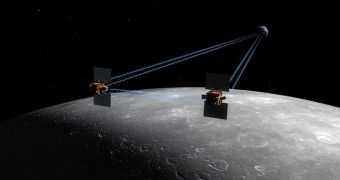The two identical space probes making up the NASA Gravity Recovery And Interior Laboratory (GRAIL) mission are currently passing every single verification test engineers put them through with flying colors, rising hopes that they will indeed be ready to start their science mission in March.
The spacecraft were sent into lunar orbit for just one reason – map the gravitational pull of Earth's natural satellite. The duo needs to cover the entire surface of the Moon, and provide extremely accurate readings of its gravitational pull.
GRAIL-A was the first to achieve orbital insertion on December 31, 2011, followed by GRAIL-B on January 1, 2012. They took the high road in getting to the Moon, after spending more than 3 months completing a journey that would usually take just 3 days to finish.
NASA opted for a trajectory that would minimize the amount of fuel needed to get to the nearby destination. The Apollo missions, for example, took 3 days to reach the Moon because they were driving straight for it, Space reports.
Throughout their mission, the GRAIL probes will produce high-accuracy gravitational maps that will enable researchers to propose new scenarios of how the Moon formed and evolved, or confirm older, already-established ones.
Just a few days ago, NASA announced that 4th graders from the Emily Dickinson Elementary School in Bozeman, Montana, were the winners of a contest the space agency had set up, for renaming the probes. The youngster selected Ebb and Flow as their proposal.
At the conference announcing the winners, Massachusetts Institute of Technology (MIT) expert and GRAIL principal investigator Maria Zuber announced that the two probes were operating better than even their engineers had anticipated.
“I've said that I know now what it's like for people who raise twins, but they're very well behaved twins,” she told attendants. At this point, Zuber added, the two probes are not flying in formation.
A series of engine maneuvers is required in order for Ebb and Flow to enter their permanent flight configuration. Once this is achieved, the spacecraft will remain locked in it for the entire duration of their flight, Space reports.
“Spaceflight is a risky thing, and whenever you have two of something, it doubles the opportunity for things to go wrong. But so far so good, and both of the spacecraft are operating very well and behaving. We're really trying to keep our eye on the ball here,” Zuber concluded.

 14 DAY TRIAL //
14 DAY TRIAL //